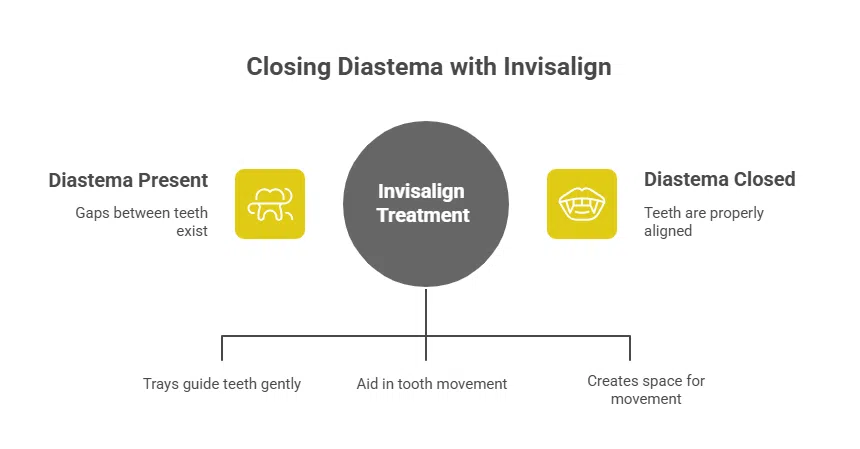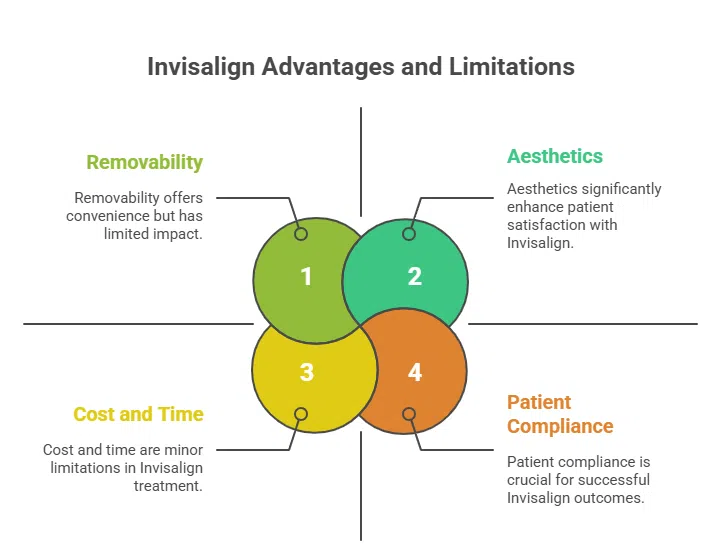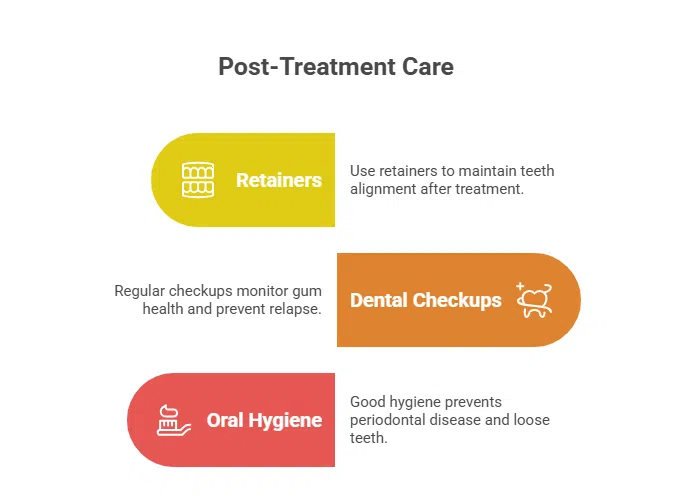At Comfort Dental Weymouth, many patients ask Can Invisalign help with diastema? Short answer is Yes, Invisalign can effectively close gaps (diastema) in many mild to moderate cases. If you’re located in Weymouth, MA, or the surrounding area, you’re probably seeking not just a cosmetic fix but one that is practical, effective, and tailored to your dental health. In this in-depth guide, we’ll explore what diastema is, how Invisalign works to correct it, how long it takes, what it costs in Weymouth, when it may not be the best solution, and how to maintain results long-term.
Understanding Diastema
What is a Diastema?
- Definition: Diastema refers to a space or gap between two teeth, often between the upper front teeth (central incisors), though gaps can occur elsewhere.
- Prevalence: Common in children; for many kids, gaps resolve when permanent teeth arrive. In adults, gaps persist and may be due to various causes.
Causes of Diastema
- Genetics (jaw size vs tooth size)
- Labial frenum (tissue between lip and gum) attachment high or large
- Missing teeth or spacing from extraction or loss
- Gum disease / periodontitis causing bone loss, tooth movement
- Habits (tongue thrusting, thumb-sucking) or abnormal swallowing reflex
Can Invisalign Help with Diastema?

What is Invisalign?
- A clear aligner system that uses a series of custom-made, removable trays to gently guide teeth into desired positions.
- Material: usually SmartTrack® or similar, designed for predictable force application.
Effectiveness of Invisalign for Diastema
- Small to moderate gaps: Invisalign is quite effective for closing these kinds of gaps within a few months.
- Midline diastema (gap between front teeth): commonly treatable with Invisalign, often with additional tools like attachments or interproximal reduction (IPR) when needed.
- Severe gaps or gaps involving missing teeth: may demand additional or alternative treatments (bonding, veneers, implants), orthodontic anchorage, perhaps even surgery for frenulum issues.
Clinical Case Example
- The “Treating Midline Diastema and Deep Bite” case: a patient had a midline diastema along with a deep bite. Treatment took 7 months using Invisalign Lite plus attachments. IPR of around 0.3 mm was used; retraction and adjustments helped close the gap.
- This shows that treatment time and techniques depend heavily on the initial condition.
Invisalign Treatment Process in Weymouth, MA (Comfort Dental)
Initial Consultation & Assessment
- At Comfort Dental Weymouth, your first appointment includes digital scans, X-rays, photographs of teeth and gums. We’ll measure the gap, assess bite, check health of gums and bone.
- If a labial frenum is involved, may need evaluation by periodontist if removal (frenectomy) is required.
Treatment Planning
- A custom treatment plan is mapped out, using 3-D imaging (often iTero or similar scanner) to simulate tooth movement.
- Deciding whether to use attachments (small clear bumps attached to teeth to aid movement), whether to perform IPR (slight reduction of enamel between teeth) for better space closure.
Wearing Aligners & Timeline
- Usually patients wear aligners 20-22 hours per day, removing only for eating, brushing, flossing.
- Each aligner is worn for 1-2 weeks before switching to the next.
- For small to moderate diastema, treatment can take 3-6 months; for larger or more complicated cases (with bite issues, bone loss, missing teeth) maybe 9-18 months or more.
Local Costs & Considerations
- In Weymouth, MA, typical cost for Invisalign can vary widely depending on severity of diastema, whether additional treatments (bonding, frenectomy) are required, patient compliance, etc.
- Comfort Dental Weymouth offers personalized quotes. Many patients use dental insurance, payment plans.
Advantages & Limitations of Invisalign for Diastema
Advantages
- Aesthetics: Aligners are nearly invisible, more discreet than metal braces.
- Removability: Easy to maintain oral hygiene, eat normally.
- Comfort: Smooth plastic vs wires and brackets.
- Predictability: digital plans allow preview of likely result; can see simulation.
Limitations & When Invisalign May Not Be Ideal
- Very large gaps, missing teeth: may need restorations or implants.
- Frenum issues or bone loss: might require surgical procedures or periodontal treatment.
- Patient compliance is critical. Poor wear time delays treatment significantly.
- Cost and time: more complicated cases = more expense, longer treatment.
- Risk of relapse: after treatment, data and case studies show gaps can reopen unless retainers are used faithfully.
How Long Does Invisalign Take to Close a Gap?
- For mild diastema (small gap, healthy gums): 3-6 months often possible.
- Moderate to large gaps, complex factors (bite alignment, attachments, IPR, frenectomy): 6-12 months or more.
- Retention phase: often permanent or long-term retainers, especially if there is any risk of relapse.
Why Choose Comfort Dental Weymouth for Diastema with Invisalign
- Local expertise: Comfort Dental Weymouth is familiar with the unique needs of Weymouth, MA patients.
- Experienced staff: Board-certified practitioners and hygienists who coordinate orthodontic and periodontal care.
- State-of-the-art technology: digital scanning, 3D imaging for precise treatment plans.
- Transparent pricing & financing: we help patients understand cost of Invisalign in Weymouth, payment plans to make treatment affordable.
- Patient stories & case portfolio: real examples from Weymouth residents who closed gaps with Invisalign.
Maintenance & Keeping Your Diastema Closed
- Use of retainers post-treatment (either clear retainers or bonded/lingual retainer).
- Regular dental checkups to monitor gum health; ensure no relapse due to shifting.
- Good oral hygiene to avoid periodontal disease which may loosen teeth.
“People Also Ask” Section
- Can Invisalign close the gap between my front teeth (midline diastema)?
Yes—Invisalign is effective for closing a midline diastema in many cases, especially when the gap is mild to moderate. Attachments and possibly IPR may be used to help achieve the closure. - How long will Invisalign take to close a diastema?
For small gaps, often 3-6 months; for larger gaps or more complex cases, 6-12 months or longer, depending on individual factors. - Will I need additional treatments (bonding, frenectomy) with Invisalign to fix diastema?
Sometimes yes. If the frenum is large, or if missing teeth contribute to the space, or the enamel shape is uneven, adjunctive treatments may be recommended. - Is Invisalign more comfortable than traditional braces for closing gaps?
Generally yes. The smooth plastic aligners tend to cause less irritation, and removability makes hygiene easier, reducing risks of irritation from trapped food. - Do I need to wear a retainer after Invisalign for diastema?
Yes—retention is crucial to maintaining results and preventing the gap from reopening. - Can I keep a small gap in my teeth during Invisalign if I like the look?
Yes, patient goals can be customized. If you want to maintain a gap (for aesthetic or cultural reasons), discuss this with your orthodontist so the treatment plan is adjusted accordingly. - How much does Invisalign cost in Weymouth, MA for closing diastema?
Costs vary depending on severity, additional treatments, insurance. Comfort Dental Weymouth can provide estimates. - Does Medicaid or dental insurance cover Invisalign for diastema in MA?
It depends on your insurance plan. Some plans cover orthodontic treatment; others consider it cosmetic. We recommend checking with your provider. - What happens if I don’t wear my aligners as much as prescribed?
Treatment may be delayed; gaps may not close appropriately; you may need longer overall treatment time, or aligners might not fit correctly. - Are the results permanent after closing diastema with Invisalign?
Results can be long lasting if you adhere to using retainers, maintain oral hygiene, and have any underlying issues (gum or bone health, frenulum) properly addressed.
Frequently Asked Questions (FAQs)
- Q: What size of gap is considered treatable with Invisalign alone?
A: Usually gaps up to ~5-6 mm are treatable with Invisalign plus attachments and optionally IPR. Larger gaps or missing teeth might need additional cosmetic or restorative work. - Q: Can Invisalign correct diastema in children or teens?
A: Yes, if growth is favorable and patient compliance is good. But in younger patients sometimes mixed dentition or erupting teeth complicate things; early evaluation helps. - Q: Does closing a gap affect speech?
A: Sometimes gaps (especially large, front-teeth gaps) can cause speech issues (like a lisp); closing them can improve speech. Temporary changes during treatment are possible, but usually resolve. - Q: Will my gums hurt when using Invisalign for diastema?
A: Some mild discomfort or pressure is normal when switching aligners. If gums are healthy, pain is minimal. If there’s gum disease, treatment of gums first is important. - Q: Is Invisalign painful?
A: It can cause mild soreness or pressure, especially when moving teeth or after switching trays. This typically lasts a few days. - Q: How often will I see the dentist/orthodontist during treatment?
A: Usually every 6-10 weeks, to check progress, ensure aligners are fitting and moving teeth as planned. - Q: What if my gap is due to a large labial frenum?
A: A frenectomy (surgical removal or adjustment of the frenum) might be needed either before or during treatment to prevent relapse after gap closure. - Q: Can bone loss from gum disease prevent Invisalign from working?
A: Significant bone loss can affect stability and limit movement. Periodontal therapy may be required first. - Q: If I had braces before, can I use Invisalign for a new or recurring diastema?
A: Yes—Invisalign can be used for relapse cases. However, prior orthodontic history, retention status, and current alignment must be evaluated. - Q: Will insurance pay for Invisalign to correct a diastema?
A: It depends on your insurance plan and whether the treatment is considered medically necessary vs cosmetic. Comfort Dental Weymouth can help verify benefits.
Conclusion
So, can Invisalign help with diastema? The short answer: yes, for the majority of cases involving mild to moderate gaps, Invisalign is a discreet, comfortable, and effective treatment. In Weymouth, MA, at Comfort Dental, we combine modern aligner technology, experienced practitioners, and personalized care to help close gaps between teeth, correct spacing issues, and give you a confident smile.
If you live in Weymouth or nearby and are considering closing a gap between your teeth, schedule a consultation with us. We’ll evaluate your case—gap size, gum health, bite alignment—and help you see when Invisalign is the best option for you, how long it will take, what it will cost, and how to keep your smile beautiful for years to come. If you are looking for a Weymouth dentist near you, please visit Comfort Dental Weymouth, 47 Washington St, Weymouth, MA 02188, (781) 337-3300.


